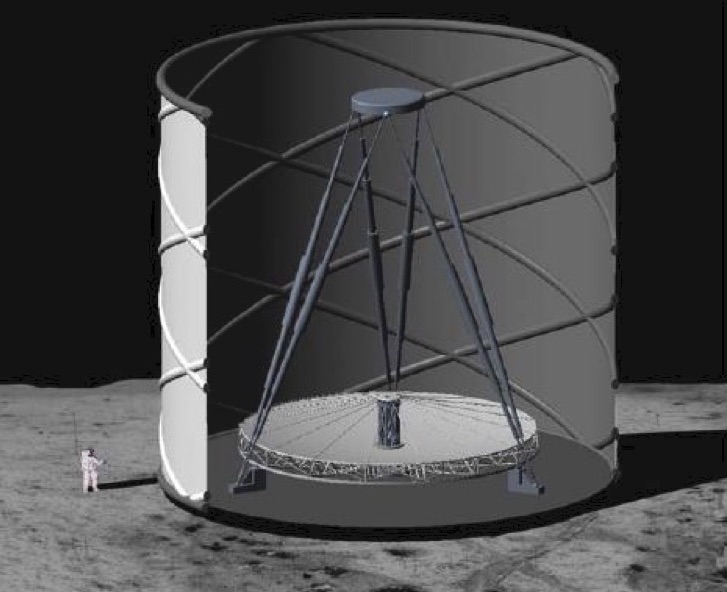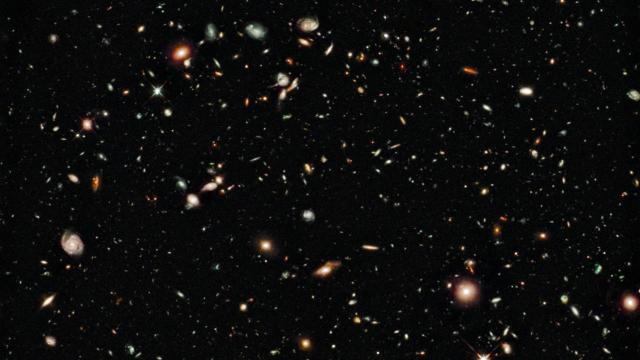A team of astronomers is reviving an idea that NASA sidelined a decade ago, in which a huge observatory would be installed on the Moon. Dubbed the “Ultimately Large Telescope,” the facility would easily outperform every other telescope in its class and spot objects that are predicted by theory but have never been seen.
A large liquid-mirror telescope installed on the lunar surface could perform a task that no other telescope can: searching for the signs of the first stars in the universe. Even the very powerful, upcoming James Webb Space Telescope, which is scheduled to launch on October 31, 2021, will not be able to see the earliest stars.
Such is the contention of astronomers from the University of Texas at Austin, who have detailed their argument in a paper set to be published in a future issue of Astrophysical Journal (a pre-print is currently available at the arXiv).

The concept dates back to 2008, when a team of astronomers from the University of Arizona proposed the lunar liquid-mirror telescope. NASA flirted with the idea soon afterward but ultimately abandoned the concept due to the dearth of relevant science having to do with Population III stars — the first stars to appear in the universe. A telescope on the Moon would be able to peer into space unhindered by atmospheric effects and light pollution.
“Throughout the history of astronomy, telescopes have become more powerful, allowing us to probe sources from successively earlier cosmic times — ever closer to the Big Bang,” Volker Bromm, a co-author of the paper, said in a statement from the University of Texas McDonald Observatory. “The upcoming James Webb Space Telescope will reach the time when galaxies first formed.”
Trouble is, JWST — as powerful as it will be — will not be capable of spotting smaller, dimmer objects that existed prior to the formation of galaxies, namely Pop III stars. The “moment of ‘very first light’ is beyond the capabilities even of the powerful JWST, and instead needs an ‘ultimate’ telescope,” said Bromm.
Pop III stars popped into existence a few hundred million years after the Big Bang, having spawned from a hydrogen and helium gas mixture. Theory suggests they were anywhere from tens to hundreds of times larger than our Sun, but even then, that’s no match for the size and luminosity of an entire galaxy. As such, Pop III stars have eluded detection.
That said, the authors of the new study, led by NASA Hubble fellow Anna Schauer, contend that Pop III stars should be detectable. We just have to spot their spawning grounds, which are expected to take the form of “minihalos.” The earliest stars were born inside tiny proto-galaxies, but the luminosities of these objects are “too faint to be detected even by the longest exposure times,” as the authors write in their paper.
“Our neighbouring galaxy Andromeda has roughly one trillion stars, and we can see it with the bare eye only in very dark locations on the Earth,” explained Schauer in an email. “These tiny first galaxies have 10 to 1,000 stars, and are much farther away — it took the light more than 13 billion years to reach Earth. Both factors play together, and we expect that minihalos are about 100 trillion times fainter than Andromeda.”
By studying the Pop III stars, we can study conditions in the early universe, she added.
“In the early universe, before those first stars emerged, visible matter was composed of hydrogen and helium only. Stars are necessary to ‘breed’ higher elements, for example oxygen and carbon, that are fundamental for life,” said Schauer. “We are running computer simulations to better understand Pop III stars, but we are still not sure how massive and how big these first stars were and if they formed in larger or smaller clusters. These questions could be answered with observations.”
That’s where a lunar observatory can help. And indeed, Schauer and her colleagues ran the numbers, finding that a sufficiently large mirror-telescope on the lunar surface should do the trick. Niv Drory, a co-author and senior research scientist with McDonald Observatory, said the proposed Ultimately Large Telescope is “perfect” for the challenge.
Situated at the Moon’s north or south pole, the stationary mirror would measure 100 metres across. The telescope would be autonomous and powered by a nearby solar power station. The observatory would transmit data to a satellite placed in lunar orbit.
The telescope’s mirror would be made from liquid, as opposed to glass (this solution is lighter and more affordable in terms of transport). The mirror would have to spin continuously to maintain the liquid surface in a parabolic shape. A metallic liquid would comprise the top layer of the mirror to provide the needed reflectivity. To prevent excess heat from ruining the show, the telescope would be built inside an impact crater and placed within a perpetual shadow.
As the authors write, however, “it is unclear what effect lunar dust would have on the instrument and the observations.”
Peering up into the cosmos, the Ultimately Large Telescope would fixate on a single patch of sky to absorb as much light as possible, as it searches for minihalos in the near-infrared and at extreme redshifts (objects whose light is very redshifted — meaning the wavelengths have been stretched out by the expansion of space — are farther away, and the farther away we look into space, the deeper into time we’ll see). As the authors note in their paper, the minihalos should produce a distinctive signature, so they should be “identified unambiguously.”
Sure, we wouldn’t be looking directly at Pop III stars, but we would be looking at their formation sites — a kind of smoking gun for their existence, and certainly the next best thing.
Looking ahead, Schauer is excited for the launch of JWST, which will allow scientists to study the early universe, including the first generation of stars that appeared after Pop III star formation.
“For the future, I hope that both theorists and observers will work together to develop the technology for this Moon telescope further,” she said. “I also hope that humans will return to the Moon, to potentially set up a site where the ULT could be built.”
This isn’t the only proposal to build a large telescope on the Moon. NASA JPL roboticist Saptarshi Bandyopadhyay has outlined his vision for a lunar observatory, which would be built inside a large impact crater. Unlike the Ultimately Large Telescope (which will look for sources of infrared light), the Lunar Crater Radio Telescope would be an ultra-long-wavelength radio telescope capable of detecting some of the weakest — and most distant — signals travelling through space. Bandyopadhyay’s project is currently in phase one of NASA’s Innovative Advanced Concepts (NIAC) program.
Perhaps we’ll see a NASA NIAC phase one for the Ultimately Large Telescope some day. The first stars are growing impatient.
